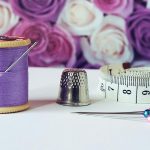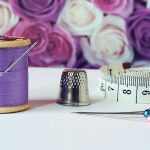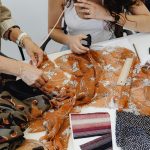When you're tackling a quilting project, you might underestimate the role of pinning, but it's a vital step that can make or break your work. Proper pinning not only enhances accuracy but also prevents the frustration of fabric shifting while you sew. By creating a stable foundation, you can maintain your design's integrity and save time by avoiding the need for unpicking. However, it's essential to understand the different types of pins and techniques to get the best results. What's often overlooked is how these choices can impact your project's success.
Table of Contents
Key Takeaways
- Proper pinning enhances accuracy, preventing fabric shifting and ensuring flat seams in quilting projects.
- Using the right pins for different fabric types helps maintain alignment and prevents damage during sewing.
- Effective pinning saves time by reducing the need for unpicking stitches due to misalignments.
- Strategically placed pins distribute pressure evenly, minimizing puckering and ensuring design integrity in quilts.
Benefits of Proper Pinning
Proper pinning enhances accuracy and prevents fabric shifting, making your quilting projects easier and more enjoyable. When you pin your layers together securely, you create a stable foundation that helps maintain the integrity of your design. This stability allows you to sew with confidence, knowing your pieces won't slide out of place as you work.
Additionally, proper pinning saves you time and frustration. You won't have to spend extra moments unpicking stitches or correcting misaligned fabrics, which can disrupt your workflow. By investing time in pinning, you set yourself up for a smoother sewing experience.
Using the right technique also helps distribute pressure evenly across your fabric layers. This prevents puckering and ensures that seams lie flat, giving your finished quilt a professional look. Plus, with less shifting, you can better achieve the intricate patterns and designs you envision.
Lastly, proper pinning can even reduce the risk of needle breaks and fabric tears. By holding everything in place, you lessen the chance of your sewing machine struggling with layers that are out of alignment. Overall, embracing proper pinning techniques is an essential step toward quilting success.
Types of Pins for Quilting
When it comes to quilting, choosing the right pins is essential for a smooth process.
You'll find straight pins are great for holding layers together, while specialty pins can offer unique features for specific tasks.
Let's explore these options so you can pick what works best for your projects.
Straight Pins Overview
Straight pins come in various types, each designed to meet specific needs in your quilting projects. Choosing the right straight pin can make a significant difference in the accuracy and ease of your work. Here are four common types you might consider:
- Standard Straight Pins: These versatile pins are great for everyday quilting tasks. They're strong and easily available.
- Glass Head Pins: With heat-resistant glass heads, these pins can withstand ironing without melting. They're fabulous for delicate fabrics.
- Quilting Pins: Longer and sturdier than standard pins, quilting pins are ideal for holding multiple layers of fabric together, making them perfect for thicker quilts.
- Fork Pins: These unique pins have a forked design, allowing you to hold several layers of fabric simultaneously. They're especially useful for matching seams or curves.
Using the right straight pin for your project not only keeps your fabric in place but also enhances your overall quilting experience. By understanding these options, you'll be better equipped to choose the perfect pins for your next masterpiece.
Specialty Pins Features
Specialty pins can elevate your quilting projects by offering unique features tailored for specific tasks.
For instance, you'll find curved safety pins that are perfect for basting layers of fabric together, allowing you to secure multiple layers without distortion. These pins glide smoothly through fabric, making your basting process quicker and more efficient.
Another option is the flower head pin, designed with a flat, flower-shaped head that makes it easier to grasp and remove as you sew. This design also helps prevent fabric shifting, ensuring your pieces align perfectly.
If you're working with delicate fabrics, consider using silk pins. They're finer and won't leave a noticeable hole, preserving the integrity of your material.
You might also want to try glass head pins, which can withstand high heat from your iron, making them ideal for pressing seams.
Techniques for Effective Pinning
Effective pinning techniques can make a significant difference in the accuracy and quality of your quilting projects. By mastering these techniques, you'll ensure your pieces align perfectly and reduce the risk of fabric shifting during sewing.
Here are some effective pinning strategies to consider:
- Use the Right Pins: Choose pins that suit your fabric type—shorter pins for delicate fabrics and longer ones for thicker layers.
- Pin at a 90-Degree Angle: Insert pins perpendicular to the seam line. This allows for easier removal as you sew, minimizing the chance of hitting a pin with your needle.
- Space Pins Evenly: Distribute pins at regular intervals along the seam. This helps maintain fabric alignment and prevents any bulging or puckering.
- Avoid Over-Pinning: While it's tempting to use plenty of pins, excessive pinning can lead to confusion and slow your sewing process. Aim for a balance that keeps your fabric secure without creating clutter.
Common Pinning Mistakes to Avoid
Many quilters make crucial pinning mistakes that can compromise their project's accuracy and finish.
One common mistake isn't using enough pins. If you skimp on pins, your fabric can shift as you sew, leading to uneven seams. Make sure to use plenty of pins to keep everything aligned.
Another mistake is pinning too close to the seam line. When you place pins too close, you might end up sewing over them, which can cause needle damage or even break your needle. Aim to position pins at least a quarter-inch from the seam.
Also, avoid pinning in a way that creates tension in your fabric. If your fabric feels stretched or pulled, it can distort your design. Instead, pin in a way that allows your fabric to lay flat.
Pinning for Different Fabric Types
When you're pinning for different fabric types, it's crucial to adjust your techniques accordingly.
Lightweight fabrics require gentle handling, while stretchy materials need more care to avoid distortion.
Heavyweight materials, on the other hand, can withstand stronger pinning strategies for stability.
Lightweight Fabrics Techniques
Pinning lightweight fabrics requires a delicate touch to prevent shifting and ensure smooth seams. When working with these types of fabrics, you'll want to use a few specific techniques for best results. Here's a quick guide to help you pin effectively:
- Use Thin Pins: Opt for fine, thin pins to avoid leaving large holes or marks in the fabric. This keeps the fabric's integrity intact.
- Pin Sparingly: Instead of overloading your project with pins, space them about 2-3 inches apart. This allows the fabric to move more freely without losing alignment.
- Pin Parallel to the Seam: Position your pins parallel to the seam line. This makes it easier to remove them as you sew, reducing the chance of breaking a needle.
- Avoid Stretching: When you pin, be mindful not to stretch the fabric. Hold the edges gently to keep them aligned without distorting the material.
Stretchy Fabric Considerations
Understanding how to pin stretchy fabrics is essential for achieving smooth seams and preventing distortion during your quilting projects. When working with materials like knits or jersey, you need to use specific techniques to ensure your pieces stay aligned.
Here's a quick reference guide to help you choose the right pinning method for different stretchy fabrics:
| Fabric Type | Recommended Pin Type | Pinning Technique |
|---|---|---|
| Cotton Spandex | Fine Pins | Pin every 2-3 inches |
| Jersey Knit | Ballpoint Pins | Use a zigzag pattern |
| Lycra | Safety Pins | Pin in a grid pattern |
| Stretch Velvet | Long Quilting Pins | Pin on seams and edges |
| Neoprene | Upholstery Pins | Pin only at critical junctions |
Heavyweight Materials Strategies
Heavyweight materials like canvas and denim require specific pinning strategies to maintain alignment and avoid shifting during quilting.
When you work with these fabrics, it's essential to use the right techniques to ensure your project turns out perfectly. Here are four strategies to help you pin effectively:
- Use thicker pins: Opt for heavier-duty pins that can easily penetrate the fabric without bending. This helps hold the layers securely in place.
- Pin at intervals: Instead of placing pins too close together, space them out every 6 to 8 inches. This allows for better distribution of pressure and reduces the risk of fabric shifting.
- Avoid excessive pinning: While you want to secure your fabric, too many pins can create bulk and hinder movement. Find a balance that keeps everything in line without overwhelming your material.
- Pin perpendicular to the seam: Position your pins at a right angle to the seam line. This makes it easier to remove them while sewing, preventing any disruptions in your workflow.
Enhancing Precision With Pinning
Using plenty of pins in your quilting projects can significantly boost your accuracy and prevent fabric shifting during sewing. When you secure your fabric with pins, you're creating a stable foundation that helps maintain the alignment of your pieces. This is especially crucial when working on intricate designs or when piecing together multiple layers.
To get the most out of your pinning technique, insert the pins perpendicular to the seam line. This method allows for easy removal as you sew, minimizing interruptions. Don't hesitate to use more pins than you think you need; they're your best allies in achieving a precise finish.
If you're working with bias edges or curves, place pins closer together to ensure the fabric stays in place, reducing the risk of puckering.
After pinning, take a moment to double-check your layout before you start sewing. A quick glance can save you from having to unpick seams later on. Remember, the time you invest in pinning will pay off with beautifully crafted quilts.
Frequently Asked Questions
Can I Use Regular Sewing Pins for Quilting Projects?
You can use regular sewing pins for quilting projects, but they might not hold thicker layers securely. Consider using quilting pins, which are longer and designed to handle multiple fabric layers more effectively during your sewing.
How Do I Choose the Right Pin Size for My Quilt?
To choose the right pin size for your quilt, consider the fabric thickness and weight. Generally, longer pins work better for thicker layers, while shorter ones suit lightweight fabrics. Don't forget to test them first!
Is Pinning Necessary for All Quilting Techniques?
Pinning isn't necessary for every quilting technique, but it helps maintain fabric alignment, especially in intricate designs. You'll find that using pins can enhance accuracy and reduce frustration, making your quilting experience smoother overall.
How Do I Store My Quilting Pins Safely?
To store your quilting pins safely, use a magnetic pin holder or a dedicated pin cushion. Keep them away from moisture and in a designated spot, ensuring you can easily find them when you need them.
What Are the Best Practices for Removing Pins While Sewing?
When removing pins while sewing, always pull them out in the direction of your stitching. This prevents fabric shifting. Keep your eyes on the needle, and don't rush—maintain a steady pace to avoid accidents.
- Hanes Nano-T vs. Beefy-T: A Ringspun Cotton Showdown - June 23, 2025
- The History of the Ringspun Clothing Brand: From UK Fad to Vintage Find - June 23, 2025
- Is Ringspun Cotton Good for Polyester Blends? (e.g., 80/20 & 60/40) - June 23, 2025







